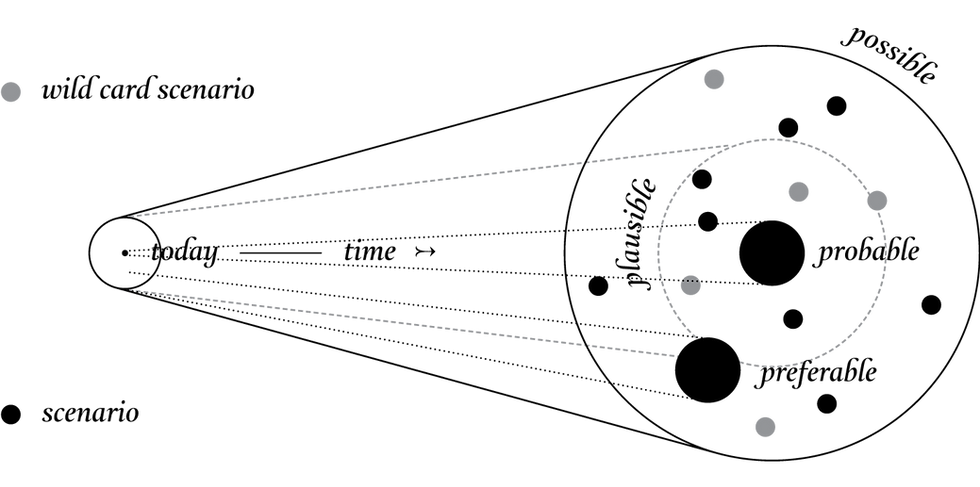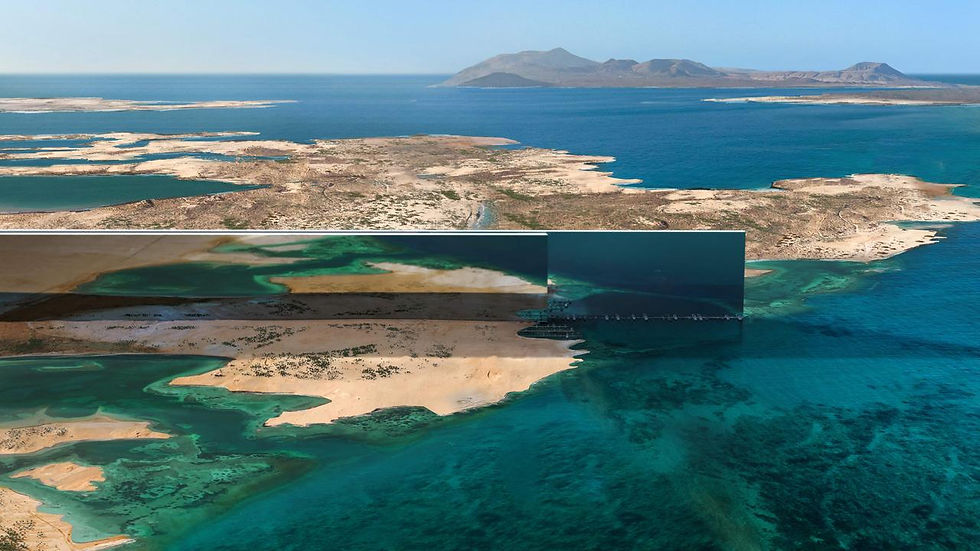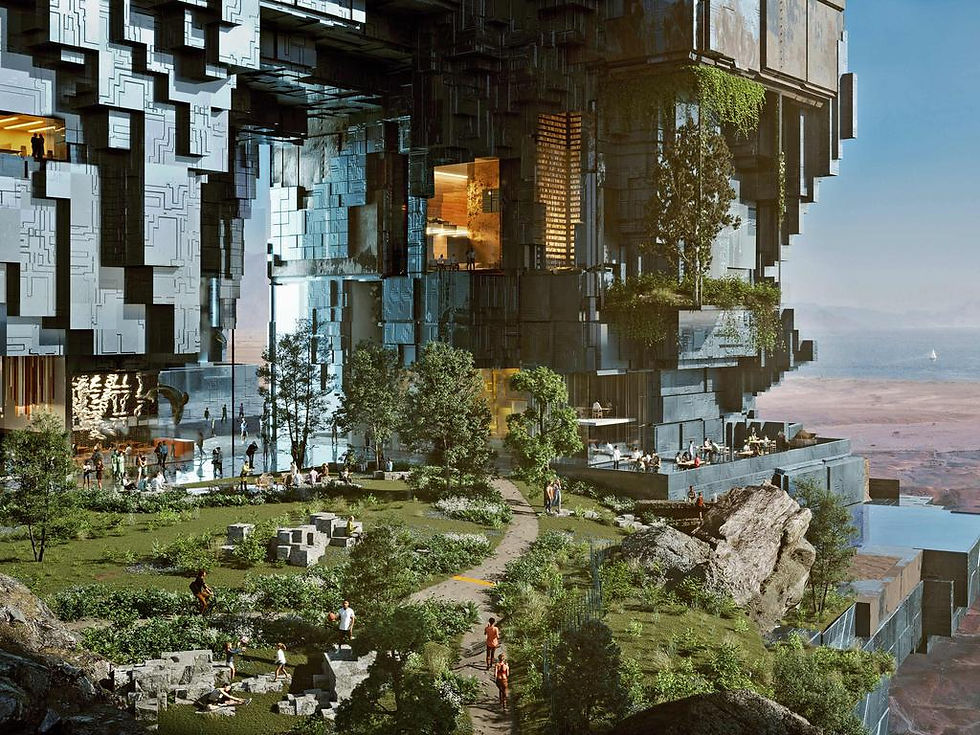Speculative Design
- Fiona Yoon
- Aug 2, 2022
- 5 min read
Updated: Apr 30, 2024
Speculative design is a design methodology that focuses on the potential of our future and the large systems. This methodology aims to address possible social, economic, technological, environmental, or political scenarios in our future. Speculative design compares to other design frameworks as it anticipates the future and helps us reshape our thoughts, ideas, and understanding of today's world and what it may become. With this, we know that everyone has different worldviews, values, experiences, and understandings, so all designers will have different ideas when applying this methodology to their practices. This opens up many creative designs and ideas for future scenarios and better prepares for our future. Instead of just predicting what our future will be and what we desire, this framework also considers the role of possible new technologies that help deal with futures that may approach. Another difference of this framework is that the success of the speculative approach relies on how believable the designed artefacts seem to be to the audience rather than the initial impacts in the current time when the design is being prototyped. Unlike other design methodologies, which tend to design for current issues and work around a specific problem to solve, the speculative design uses imaginaries of possible future scenarios. The common design framework I have encountered in the design program is the double diamond process, where we use existing research and resources to create our prototypes. Unlike this framework, the speculative design method has no indicator of the future and maximizes our design imagination. As speculative designs work with futuristic scenarios, designers can exceed the boundaries of what could be achieved in today's world. With this methodology, we designers create possible, probable, plausible, and preferable designs that think into the future of our society, technologies, resources, and other factors.
“Speculative design gives designers an opportunity to stretch their imaginations and develop
new and boundary-pushing systems and prototypes for the future” (Tran, 2019).

Introduction to Speculative Design Practice (Mitrović, n.d.)
Beyond speculative design
A key beneficial aspect of speculative design is that it maximizes room for creativity and does not limit the formation of potential scenarios about our future. Not being limited in our creativity allows more room for designers to extend ideas about our future and ideate designs. Although designs that follow this method may seem fictional now, projects such as ‘Flying cars’ have had a time of seeming unrealistic but now have come to reality (Lim, 2021). This case study shows that speculative design allows designers to think into the future now and have the ability to create a beneficial impact on our society and a major change in our technology field in the future. Like this case study solving a large-scale issue on traffic and population, other designs using this speculative design lens also can work towards solving large-scale issues.
A limitation of this design mode is that it is hard to determine the success and impacts of the design, as it depends on the believability of individuals over many years. It is impossible to grasp what our future holds and explore how society would have changed over time. We are unable to know what resources and technologies are available to us designers, as well as the possible change in society's world views in many years. As it is difficult to determine its success and usefulness for the future, companies are less likely to invest time and funding into developing speculative design projects.
Although the speculative design is a great way to open up wide perspectives of our future and bring individual interpretations into design thinking, working with others in group projects may be difficult. In speculative designs, designers do not rely on facts and current real-world scenarios, they tend to design using their personal beliefs and desires. So this may create ignorance and confusion when understanding others' visions when collaborating on group projects.
Case study - Saudi Arabia Megacity

Saudi Arabia's plan for enormous mirror-wall, skyscraper city called The Line (Chung, 2022)
The 100-mile-long mirrored skyscraper megacity project planned in Saudi Arabia, designed by US studio, Morphosis, has equipped the speculative design framework.
RAISE the capacity of Saudi Arabia
REDUCE the carbon footprint
BENEFIT the health and wellbeing of individuals
One of the aims of this project is to “Raise the capacity of Saudi Arabia, get more citizens and more people in Saudi Arabia” (Chung, 2022). The layout of the megacity is built vertically with many layers and proposes that the city will eventually house up to 9 million people. This project also hopes to reduce the carbon footprint of infrastructure to create a positive impact on climate change by running on renewable energy and creating the ideal environment. The city will run fully on renewable energy and condense the footprint of our current cities into 34 square kilometers (Chung, 2022). The compact city, paired with the ideal climate, would allow citizens to travel by foot, with only a maximum 20-minute trip from one end of the city to the other. This covers another goal of this megacity, to prioritize the health and wellbeing of the citizens. The concept of “vertically layered” communities with surrounding parks and public spaces will provide citizens with more experience in the outdoors. This project is said to be "a place of unparalleled social and economic experimentation – without pollution and traffic accidents – coupled with world-class preventive healthcare so that people will live longer” (Chung, 2022).

I believe this speculative design better achieves its goal of raising the capacity of Suadi Arabia and targeting the overarching problem of overpopulation. Unlike the case study of "Plasticful Foods" studied in class, this project has some guidance as to if this will be achievable in the future. Although designers cannot make assumptions about what our future holds and what resources and technologies are available, our current technologies show the potential for this city to be built. This design targets the inevitable global issue of overpopulation, which will only worsen as the year's pass. The world's population has been growing nonstop for 600 years, and it is expected to reach 10 billion people in the
next 35 years (The world counts, 2022). Speculative designs such as this planned megacity allow the potential for maximum impact, and the project can become a global scaled plan for countries all over the world to attack the global issue of overpopulation and climate change and assist better health and wellbeing for citizens.
References:
C. W. Lim. (April, 2021) S. Korea aims to popularize flying cars by 2035 with increased battery capacity and weight lightening. Aju Daily. https://www.ajudaily.com/view/20210401162112680
F. Chung. (28 June, 2022). Saudi Arabia's plan for enormous mirror-wall, skyscraper city called The Line. NzHerald. https://www.nzherald.co.nz/world/saudi-arabias-plan-for-enormous-mirror-wall-skyscraper-city-called-the-line/WSPELUJ37KCNMUDUFDLBGOSFOI/
The world counts. (2022). Time left until 10 billion people. The world counts. https://www.theworldcounts.com/populations/world/10-billion-people
I. Mitrović. (n.d.). Introduction to Speculative Design Practice [Diagram]. Speculative. https://speculative.hr/en/introduction-to-speculative-design-practice/


Comments